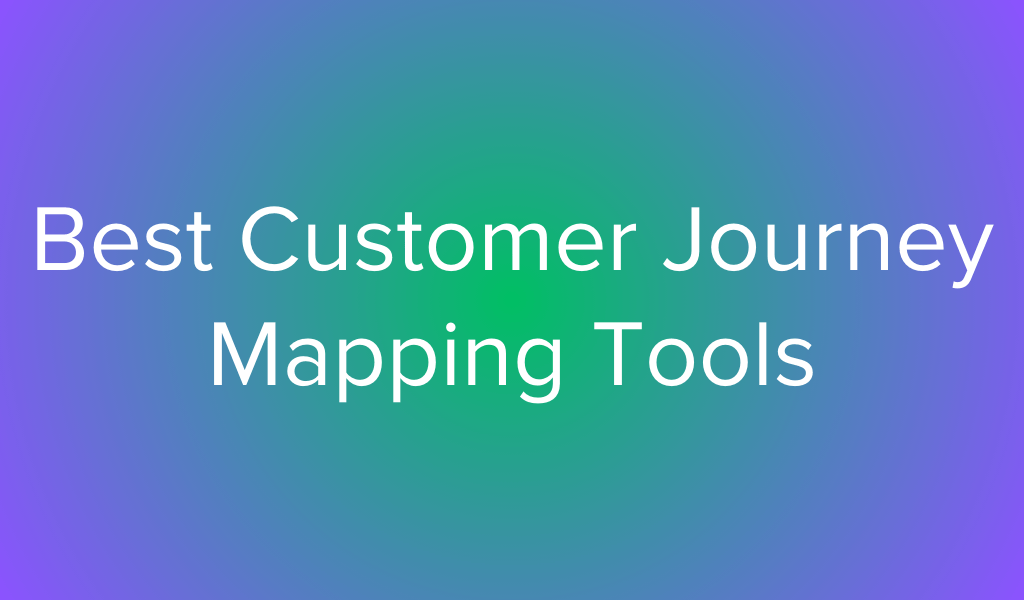10 min read
Listen and understand your customers. Win them at any stage of their journey.
cx Platform
Customer feedback is an essential tool for business growth and improvement. It is a known fact that companies that listen to their customers and act upon their feedback are more likely to succeed in the long run. However, obtaining honest and valuable feedback can be a challenge for most companies. While there are many ways to obtain feedback, it is important to choose the right approach to ensure that the feedback gathered is relevant and actionable.
You can take several approaches to encourage your customers to open up to you. In this article, we will explore ten effective methods you can implement today. Utilizing these methods can build stronger relationships with your customers, gain valuable insights into their needs and preferences, and ultimately drive more sales for your business.
Preparing to collect customer feedback
Before you begin collecting feedback from customers, it is important to take some time to reflect on why you are seeking their input. Clarifying your objectives and mapping out the path for achieving them is essential for ensuring that both your time and your customers’ time are well-spent.
To get started, consider these questions and discuss them with your team:
- What are the areas of the customer experience you would like to improve? Whether it’s onboarding, content marketing, or any other aspect of the customer journey, focus on the areas that most need customer insights.
- How do you plan on using the data that you collect? Collecting customer feedback is only useful if it leads to meaningful changes. For instance, if your customer survey reveals that your product’s user interface is confusing, ensure you are prepared to invest in fixing it before collecting feedback.
- Which channels are most effective for gathering customer feedback that aligns with your goals? Whether through surveys, focus groups, or other methods, make sure you use the channels most likely yield the insights you need.
By taking the time to carefully consider these questions and develop a plan for collecting and using customer feedback, you will be well on your way to improving your product and ensuring that your customers are more satisfied than ever before.
8 tips to get customer feedback effectively
1. Customer feedback surveys
Effective customer feedback surveys can provide valuable insights that help improve your product or service offerings. Developing a comprehensive and useful survey requires careful consideration of the questions you ask and the survey format itself.

To create a successful survey, it is important to first define your objectives and identify the specific information you hope to gather. Keep in mind that you may need to ask different types of questions depending on your goals. For example, if you want to understand customer satisfaction, you may need to ask more open-ended questions that allow respondents to provide detailed feedback.
When designing your survey, it is also important to consider the length and structure of the questions. While shorter surveys may be easier for customers to complete, they may not provide you with enough information to make informed decisions. On the other hand, longer surveys can be more comprehensive but may lead to lower response rates.
In addition to the length and structure of the survey, it is also important to consider the format in which you will deliver it. Short slider surveys on your site can be a convenient way to gather quick feedback on specific issues. However, longer, more traditional surveys may provide a more complete picture of customer satisfaction and experience.
2. Customer feedback through emails
One popular and easy method for getting customer feedback is through follow-up emails. While you can easily automate this, having a person reach out is even better.

After a transaction, meeting, or various touchpoints, have a real person reach out directly to your customer for feedback and let them know you’re always there to chat. This is the perfect job for a customer manager to dig deeper into what the customer is going through and whether your product meets their needs.
However, while customer feedback through email is a convenient and cost-effective way to gather feedback, it may not always elicit a response from your customers. Therefore, following up with your customers through other channels, such as phone calls, is important to ensure that their feedback is heard.
In follow-up emails, it’s also a good idea to not only offer a phone number, but also provide additional information about the company’s services and how the customer can benefit from them. This can help build trust and establish a stronger relationship with your customers.
While getting customer feedback through email won’t directly impact your overall CX, it can deeply impact an individual’s experience by showing that the company values their opinion and is committed to providing exceptional customer service. Additionally, by gathering feedback, the company can identify areas for improvement and make changes that will ultimately enhance the customer experience.
3. Social media
Social listening is a powerful tool for businesses looking to get customer feedback. By monitoring social media channels, companies can gain access to a wealth of information that can help them improve their products and services. In fact, social listening can give you access to an otherwise untapped reservoir of candid feedback from customers that you might not be able to get through other channels.
In addition to direct comments or mentions on social networks, many networks include built-in polling tools that businesses can use to gather customer feedback. These tools are a great way to get valuable insights from your audience and help you make more informed business decisions.
By using social listening and polling tools, businesses can better understand their customers’ needs and preferences. This can help them improve their products and services and their overall customer experience. So if you’re not already using social listening and polling tools, it’s definitely worth considering as part of your customer feedback strategy.
4. Feedback button

The Feedback Button is a unique tool in that it is always visible and remains static on the side of your website. With this feature, users can quickly and easily provide feedback on their experience without navigating through a website to find a way. The Feedback Button is especially useful for receiving actionable in-app feedback, which can be used to improve a website’s user interface or user experience. By providing this feedback, users can communicate their thoughts and ideas, and website developers can then use these ideas to make informed decisions about improving the website. Additionally, the Feedback Button eliminates the need for long, tedious surveys, which can often be boring and time-consuming for users. By providing a simple and efficient way to provide feedback, the Feedback Button helps to increase user engagement and satisfaction, ultimately leading to a more successful website.
5. Chat surveys
There are several ways to run chat surveys. One popular method is through the Intercom Messenger, which is a built-in feature for Intercom users. However, if you use a different tool, you can simply share a link to the survey in the chat window so your customers can easily access it.
The benefits of running chat surveys are numerous. Not only can they help you measure customer satisfaction, but they can also provide valuable insights into your Net Promoter Score (NPS). NPS is a metric that measures customer loyalty and advocacy, and it is calculated by asking customers how likely they are to recommend your product or service to a friend or colleague. Using chat surveys to gather feedback from your customers, you can gain a deeper understanding of their needs and preferences and use that information to improve your products or services.
6. Customer feedback through focus groups
A focus group is a powerful qualitative research technique that is used to collect feedback from a small group of individuals guided through a discussion by a moderator. It is a particularly useful method for exploring a target group’s needs, preferences, and priorities. Focus groups provide valuable context that complements quantitative research studies by getting personal experiences and stories that can’t be found in data alone.
During a focus group, the moderator encourages participants to engage in open-ended discussion about a particular topic. The group dynamic often results in a free-flowing exchange of ideas and opinions that can reveal valuable insights into the consumer mindset. Moreover, participants can build on one another’s comments, resulting in a deeper understanding of the topic.
After the focus group is completed, the data collected is analyzed and used to inform business decisions. Companies can use this information to design new products, improve existing ones, or tailor their marketing strategies to better meet the needs of their target audience.
7. Create online community
Instead of just gathering comments from social media, why not create your own network? By creating a forum feature on your website, you can provide a space for your customers to share their experiences and connect with like-minded people. This, in turn, can increase user engagement and strengthen your relationship with your customers. Additionally, creating a Facebook group can generate excellent feedback for your business.
When creating such communities, it is important to remember that they require continuous monitoring and, ideally, a full-time moderator. The moderator’s responsibilities include starting new discussions, moderating discussions, posting and updating regularly, responding to feedback, and more. This ensures that the community remains active and engaged.
Not only does providing a forum for your customers to express their feedback improve engagement, but it also provides valuable insights into their experiences with your business. You can better understand their needs and preferences by encouraging users to share their experiences, pictures, and videos. This information can then be used to improve your products and services, ultimately leading to greater customer satisfaction and loyalty.
8. Offer a reward in return for feedback
Typically, customers are more likely to send feedback after a negative experience than to provide positive feedback. However, it’s important to note that positive feedback can be just as valuable as negative feedback, if not more so. Thus, it’s crucial to encourage feedback from every customer, regardless of their experience with your product or service.
One effective way to encourage feedback is by offering incentives for their input. This not only shows customers that you value their feedback, but it also provides them with an immediate benefit for taking the time to share their thoughts. Some examples of incentives that can be offered include free shipping, discounts on future purchases, samples, or gift cards.
It’s important to remember that the incentive should be of value to the customer and not just an opportunity to cross-sell. Additionally, it’s crucial to negate the risk of this looking like a bribe by ensuring your tone underlines that this is a genuine effort to improve customer service. By doing so, you can expect to receive more feedback from your customers, which can help you identify areas for improvement and ultimately boost customer satisfaction.
Collecting customer feedback is crucial
To better your company, listen to your customers. Start by identifying your most pressing goals and collecting feedback using a simple method such as a feedback form on your website. However, to gain a comprehensive understanding of the customer experience, use more advanced tactics like usability testing and analytics. Your support team is essential in collecting feedback, so encourage them to approach every interaction as an opportunity to collect data. This will provide you with valuable quantitative and qualitative data on customer experiences, allowing you to make informed decisions on how to improve your products and services, leading to greater customer satisfaction and increased revenue.






